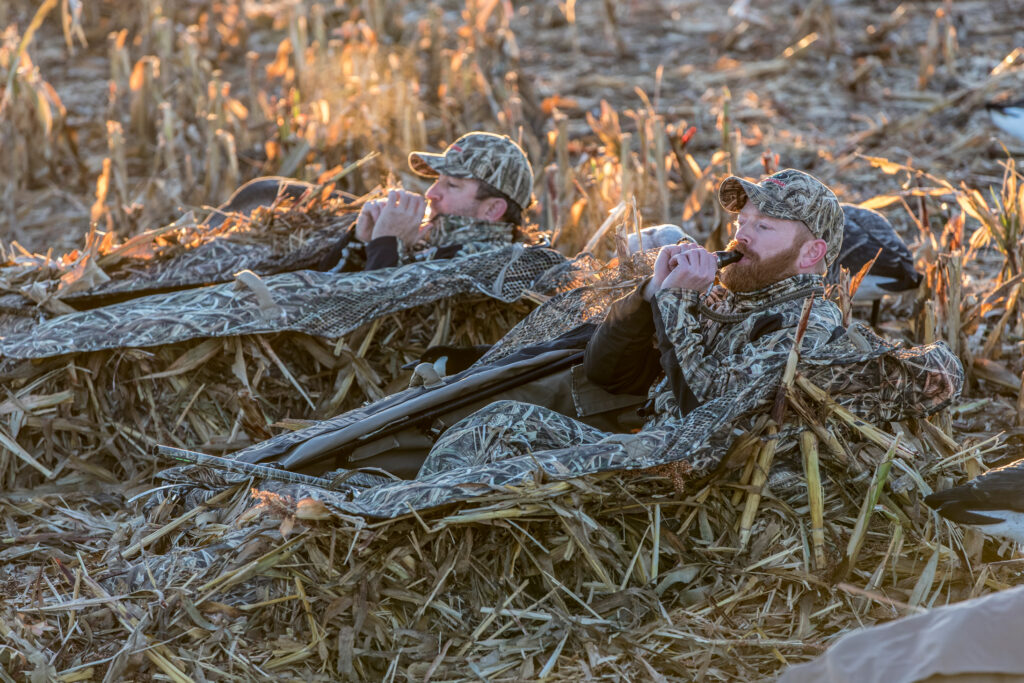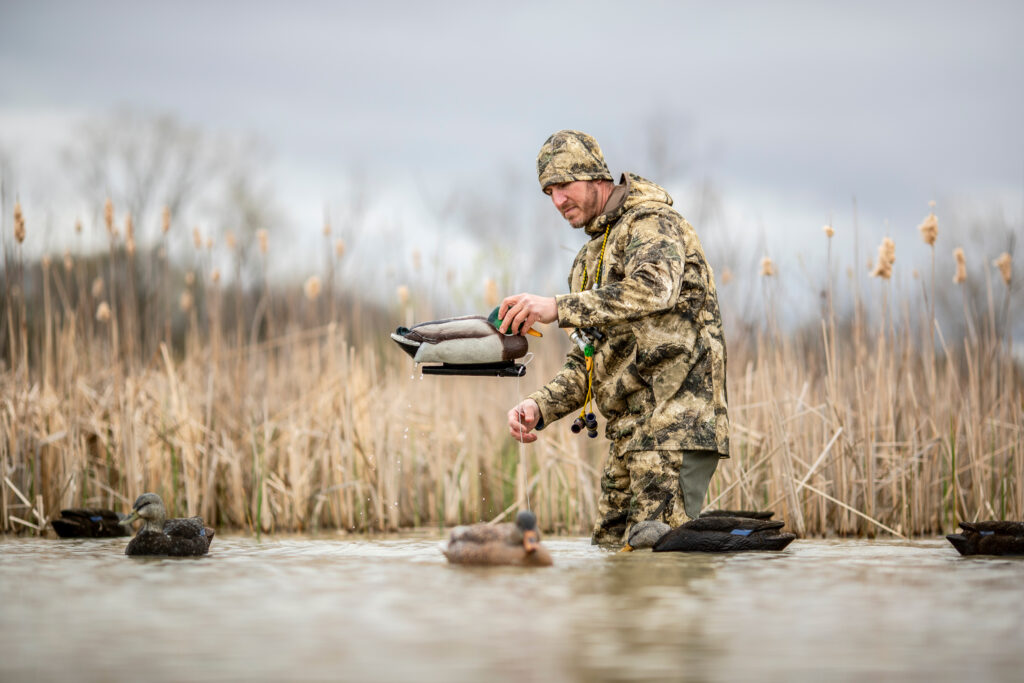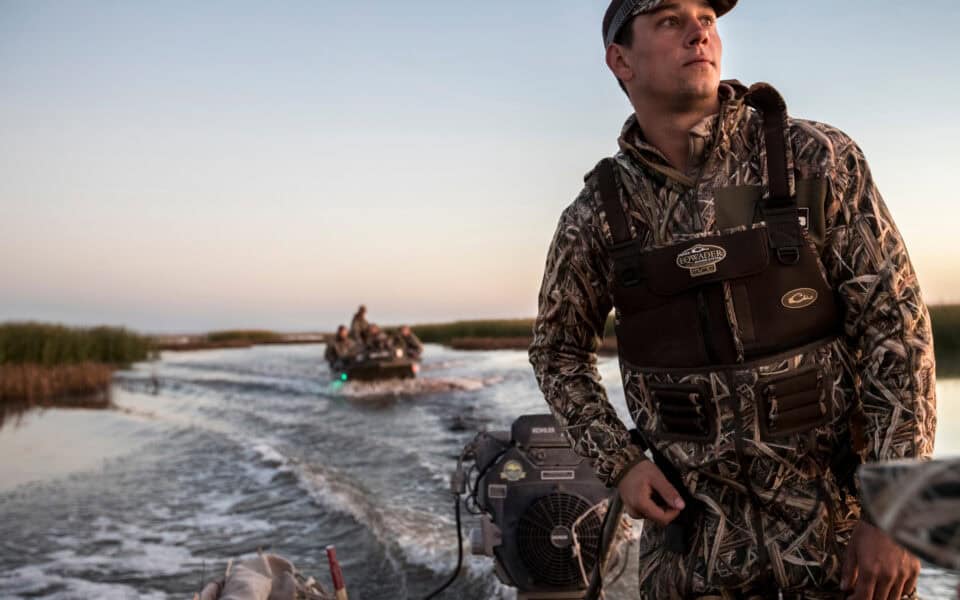Hunting with a waterfowl outfitter can be more than just a pay-to-play hunt, it is an accelerated lesson in waterfowl hunting.
As I write this, it’s early fall and the waterfowl migration is well underway. Carried by the cool north wind comes the familiar sounds of ducks, geese, and Sandhill cranes migrating south for the winter.
While waterfowl seasons open much earlier in Canada and the northern states, many of us are in more southerly states waiting for our season to open. Though it varies from state to state, the typical length of duck season in the United States is about 60 days. If you only hunt in one region your hunt-time window can be tight. Throw in family obligations, work, and the general entanglements of life and sometimes the amount of time you can have to hunt is reduced to as few as 15 to 20 days, if you’re lucky.
If you are willing to expand outside of your immediate area, there are great opportunities to both lengthen and push your hunting season forward by hitting the road to freelance or by hunting with an outfitter. Leveraging the capabilities of great applications like OnX Maps can help you find, map, and scout potential areas to hunt.
Irrespective of your desire to scout and willingness to travel, the constraint of time may still present an obstacle. One of the best ways to get on birds in a different state, region of the country, or in another country altogether is by hiring the services of a guide or outfitter.
There are many advantages to hooking up with a guide or outfitter. Here are just a few.
Maximizing Your Time in a New Place

Time is the scarcest resource of all. After your work and personal obligations, you may only have a few days off a year where, during the week, you could travel to hunt. If you want to hunt in a new area and experience all that area can offer, smart money will usually go with an outfitter. These folks are pros and they spend countless hours patterning and putting in the windshield time to find birds. What is more, they have the local knowledge and access to help you get on birds in areas unfamiliar to you or on bucket-list species that you couldn’t hope to otherwise target.

Jim Nelson
Convenience of Using a Waterfowl Outfitter
A departure from the grind of the day-to-day waterfowler’s experience, hunting with a guide can massively reduce the headaches and stressors involved with traveling to hunt. If you’re driving, you could be in your vehicle for many hours or even days. Then there’s loading, hauling and unloading decoys, blinds and other random gear. Then you are up half the night worrying about your truck getting broken into while you’re between scratchy sheets at the $29.99-a-night motel you managed to find. But hey, at least they have the free “hot breakfast” consisting of a microwaved pancake, imitation eggs, and a bottle of OJ that is a disturbingly bright hue of orange.
Don’t misunderstand, those trips can be awesome and provide some fond memories. They are unforgettable and are a great way to spend time with friends. You need to and should go on a few of those trips. However, if you don’t have the time, the hassles aren’t necessarily worth it.
Save yourself the trouble. Find a reputable guide, leave your decoys and your bed bug detection kit at home, and even your gun if you choose to. If they have a lodge, you’re likely to spend your evenings having a drink by the fire and making new friends. You’re certain to be well fed at and you’ll probably get a mid-hunt warm up meal (if you haven’t already shot all that the law will allow). Many outfitters, if they don’t already provide guns and shells, offer you the ability to rent a gun from them for a nominal fee.
Increased Likelihood of Getting on Waterfowl
Nothing is assured in the world of waterfowl. It is important to realize that hunting with a guide is not a guarantee of huge numbers of birds (or any birds at all). Wild waterfowl are not penned, released birds, these are migratory birds. Truly, they can be there one day and gone the next. You are not paying for the guarantee of birds in the freezer. You are paying for the guide’s expertise and the opportunity. However, the use of a guide significantly increases your odds.

Learn from a Waterfowl Outfitter
If nothing else, hunting with an outfitter is an excellent opportunity to expand your base of knowledge. To put some things in perspective (just back of the napkin calculations here) even if you have hunted 20 to 30 days for the last 10 seasons, some of these guides are out morning and afternoon from about September to January, and if they guide conservation hunts are pushing out into March. We are talking 150 plus hunts a season — 5:1 in comparison to the average hunter. That’s dog years. If you end up going with a guide, watch what they do and when they do it…learn from them.
Don’t ask them for the “secret sauce” or drop pins on spots, but do pay attention. Watch how they set up their decoys, how they work the dog, when they hit the call, and when they leave the calls hanging on the lanyard. Take note of their patience and how they let the birds work in and don’t call the shot the moment they break the tops of the trees or within 60 yards.
Finally, if you are hunting with an outfitter, here are a few tips to have a better experience and to be a better client;
5 Tips to Have a Better Outfitter Experience and Be a Better Client

-
Do your Homework
While Instagram and YouTube are good ways of finding guides – don’t just assume a hefty Instagram following is an assurance of a good hunt, competent guides, or good experiences by clients. Call around. Ask friends. Follow up on references. Look at the day rate. If the guide is selling day-rates at $100 per person, that should be a potential red flag. But ultimately, most of the time you do, as they say, “get what you pay for.”
-
Be Organized
Someone will inevitably become the trip leader. If someone isn’t, you should designate a trip leader to communicate with the head guide, track down deposits, and remit payments. The momentum of positive communication and timely payment of deposits has a way of carrying into the hunt and (off the record) may result in you getting to hunt in a better spot the days of your hunts. If your group is high maintenance, slow to pay deposits, and generally a “pill” to work with, you probably aren’t going to get to hunt the best spots and you’ll end up hunting their plan-B or plan-C spots and they’ll save prime spots for a more pleasant group.
-
Bring a Good Attitude
A good client is someone who shows up with a great attitude and who can have a good time even if the hunting is slow. Every guide wants you to have the best hunt of your life. There is a wide variety of factors that go into whether or not a hunt is a resounding success. A majority of those factors are completely outside the control of the guides, namely, weather, precipitation, hunting pressure locally, the hatch the previous year, strength and timing of the migration, water in the area, among others.
Going in with an open mind can really help you enjoy yourself and time with friends so much more. A good time can be had on even the slowest day of hunting.
Don’t doubt the scout. Don’t question how the decoys are laid out. Don’t question the shot call. Don’t question whether or not the guides are calling at birds. You hired the guides because they have skills and access that you do not…don’t question them.
-
Get off your Phone
Whether it’s back at the lodge or in the blind, it’s not fun to be around someone who constantly has their face down in their phone. In the blind, it is unsafe and you might end up missing the shot call because you are scrolling reels.
Beyond that, you are there to have fun and enjoy the company of those around you. You just can’t do that without getting your face out of your phone.
-
Tip your Guide
Whether or not you should leave your guide a tip or not is not a question. You should leave a tip. How much you leave can vary. Regardless of whether or not you killed a bird, you should budget to tip the outfitter anywhere from 10 to 15%. If the guides went above and beyond before, during, and after the hunt back at the lodge, you should tip 15% and higher depending on how you feel. The hunting party should split the tip across the whole group, not 10 to 15% per person. To be safe and avoid confusion, you should tip the head guide or the owner of the outfit directly and allow them to disperse the tip across the guides. They’ll know how that tip money should be allocated best.
Join our weekly newsletter or subscribe to GameKeepers Magazine.
Your source for information, equipment, know-how, deals and discounts to help you get the most from every hard-earned moment in the field.






